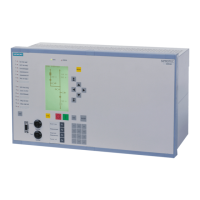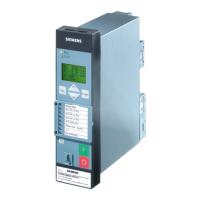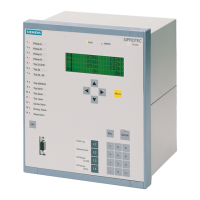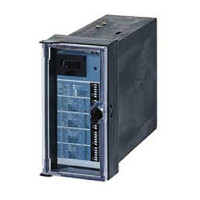Section 2.20 Reverse-Power Protection Application with Flexible Protection Function gives an application
example of the function “reverse power protection”.
The maximum 20 configurable protection functions operate independently of each other. The following
description concerns one function; it can be applied accordingly to all other flexible functions. The logic
diagram Figure 2-114 illustrates the description.
Functional Logic
The function can be switched ON and OFF or, it can be set to Alarm Only. In this status, a pickup condition
will neither initiate fault recording nor start the trip time delay. Tripping is thus not possible.
Changing the Power System Data 1 after flexible functions have been configured may cause these functions to
be set incorrectly. Message (FNo.235.2128
$00 inval.set
) reports this condition. The function is inactive
in this case and function's setting has to be modified.
Blocking Functions
The function can be blocked via binary input (FNo. 235.2110
>BLOCK $00
) or via local operating terminal
(“Control”->“Tagging”->“Set”). Blocking will reset the function's entire measurement logic as well as all running
times and indications. Blocking via the local operating terminal may be useful if the function is in a status of
permanent pickup which does not allow the function to be reset.
In context with voltage-based characteristics, the function can be blocked if one of the measuring voltages
fails. Recognition of this status is either accomplished by the relay's internal „Fuse-Failure-Monitor“ (FNo. 170
VT FuseFail
; see section 2.12.1 Measurement Supervision) or via auxiliary contacts of the voltage trans-
former CB (FNo. 6509
>FAIL:FEEDER VT
and FNo. 6510
>FAIL: BUS VT
). This blocking mechanism can
be enabled or disabled in the according parameters. The associated parameter BLK.by Vol.Loss is only
available if the characteristic is based on a voltage measurement.
When using the flexible function for power protection or power monitoring, it will be blocked if currents fall
below 0.03 · Ι
Nom
.
Parameter BLK f out of r allows you to specify whether the protection function is blocked if the meas-
ured power frequency is outside the operating range of the function (25 Hz to 70 Hz).
Operating Mode, Measured Quantity, Measurement Method
The flexible function can be tailored to assume a specific protective function for a concrete application in
parameters OPERRAT. MODE, MEAS. QUANTITY, MEAS. METHOD and PICKUP WITH. Parameter
OPERRAT. MODE can be set to specify whether the function works 3-phase, 1-phase oder no refer-
ence, i.e. without a fixed phase reference. The three-phase method evaluates all three phases in parallel. This
implies that threshold evaluation, pickup indications and trip time delay are accomplished selectively for each
phase and parallel to each other. This may be for example the typical operating principle of a three-phase time
overcurrent protection. When operating single-phase, the function employs either a phase's measured quan-
tity, which must be stated explicitly, (e.g. evaluating only the current in phase Ib), or the measured ground
current In or the measured displacement voltage Vn.
If the characteristic relates to the frequency or if external trip commands are used, the operating principle is
without (fixed) phase reference. Additional parameters can be set to specify the used MEAS. QUANTITY and
the MEAS. METHOD. The MEAS. METHOD determines for current and voltage measured values whether the
function uses the RMS value of the fundamental component or the normal RMS value (true RMS) that evalu-
ates also harmonics. All other characteristics use always the rms value of the fundamental component. Param-
eter PICKUP WITH moreover specifies whether the function picks up on exceeding the threshold (>-element)
or on falling below the threshold (<-element).
Characteristic Curve
The function's characteristic curve is always “definite time”; this means that the time delay is not affected by
the measured quantity.
Function Logic
The following figure shows the logic diagram of a three-phase function. If the function operates on one phase
or without phase reference, phase selectivity and phase-specific indications are not relevant.
Functions
2.19 Flexible Protection Functions
SIPROTEC 4, 7SJ62/64, Manual 271
C53000-G1140-C207-8, Edition 08.2016

